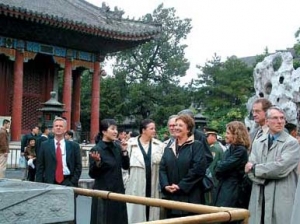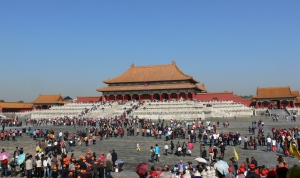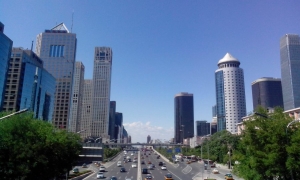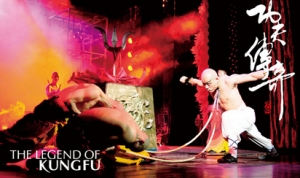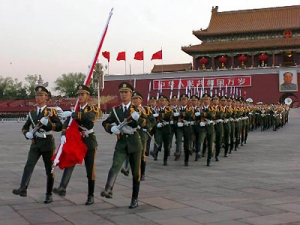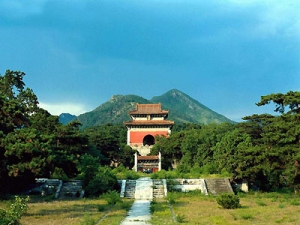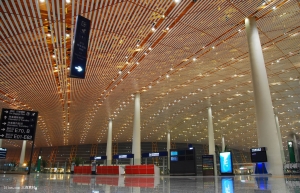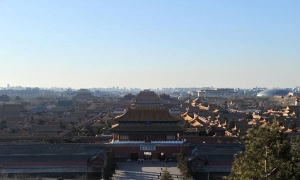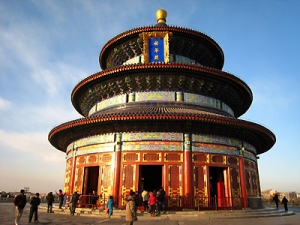Fleet
Beijing drivers not only offer you proffesional English speaking driver in beijing ,but also offer you english and spanish speaking tour guide ,Planning your trip to Beijing? Contact beijingdrivers for a private Beijing tour guide that suits your travel request and your budget. We at Beijingdrivers have over 30 English speaking tour guides with professional licenses, and we guarantee you have the best possible tour experience in Beijing.
Book online now! Our local experts will tailor-make you a perfect private Beijing tour!
Beijing's Palace Museum will be forbidden to visitors from August 22 to September 3, the museum's ticketing website shows and tourism industry sources confirmed Wednesday.
Now limited to 80,000 visitors per day, the website for the museum more popularly known as the Forbidden City shows that no tickets are for sale beginning August 22. Tourism industry sources, speaking on condition of anonymity, confirmed to the Beijinger that the Forbidden City, the former home of China's Ming and Qing Dynasty emperors, is indeed off limits until after September 3.
The Tiananmen Rostrum, at the museum's south end, has been closed since early August. Tiananmen Square and the nearby Wangfujing shopping street, will both officially be closed August 22 and 23 for rehearsals for the upcoming September 3 military parade, commemorating the 70th anniversary of the end of World War II and China's victory in the War of Resistance against Japan.
Checkpoints with armed guards are already greetings visitors to Wangfujing and some office buildings on Chang'an Avenue, which runs directly through Tiananmen Square.
Residents of the Jianguomenwai and Guanghua Lu areas will be required to keep their windows shut August 22-23, and three major streets in eastern Beijing will be shut for most of those two days, orders to area residents obtained by the Beijinger show.
This latest announcement of closures is in addition to restrictions announced for sanitun, far from the route for the September 3 military parade, for which there will be a full-scale rehearsal during this coming weekend.
All street-facing Jianguo Lu, Xi Dawang Lu, and Guanghua Lu businesses have been ordered to close from the early afternoon of August 22 until the same time on August 23, and only on-duty parade-related personnel are permitted in the area, the order said. All street-facing windows must be closed and are forbidden to be opened, the order said.
Along with these and the Sanlitun closures, the Forbidden City will stop receiving visitors from Saturday, August 22, through Thursday, September 3. Wangfujing will also be closed August 22-23, due to the parade rehearsal.
Theatre: Red Theatre (Authorized & Guarantee Tickets)
Address: 44 Xingfu Dajie, Chongwen District, Beijing
Phone: 135-2179-1983
Reviews:
Show Time: Daily 7:30-8:45pm
Ticket Price: RMB140/p.p - 600/p.
Introduction of Kung Fu Show:
Chinese Kung Fu (martial arts) is so prestigious on the global scene that Zheng zhou, Henan Province, has become the mecca for Wushu lovers who congregate there for an annual international Wushu festival. Every morning, street corners and public parks are thronged with people practicing Chinese martial arts.
The fantastic "The Legend of Kung Fu" is presented by China Heaven Creation International Performing Arts Co., Ltd. (CHC)-- China's leading performance art production company. CHC has collected a group of the best Kung Fu practitioners of China and invited the best directors and designers of the country. The show is a must-see production in Beijing for tourists and Kung Fu lovers
The Legend of Kung Fu focuses on a young boy found wondering outside an ancient temple somewhere in China. He dreams of becoming a Kung Fu master. But things do not go smoothly according to his plan. The young monk is called Chun Yi (the pure one) has to overcome many difficulties and temptations before he conquers and finally gets his sacred goal of enlightenment. Many places of the show are presented like a dream in appearance. In the show you can find the flying fairy created in Chun Yi's mind and brimstone of the blacksmiths workshop, where the tools and armor are made.
The ceiling of the theatre lights up like the night sky with twinkling stars. The main innovation in this show is the blend of the different parts of performance art. The modern dancers have mixed elements of Kung Fu into their performance and the Kung Fu performers have adopted some of the modern dance actions. The management and production team have been looking for the best performers all over China. You can find their hard work on the stage. The average age of the performers is only 17 years, but their performance tells that they are excellent
beijingdrivers.com offers online information and discount tickets on the Beijing Kung Fu Show and More Night Shows in Beijing. Keep browsing our site for more information on Beijing.
Attraction Type:
Tiananmen Square, the heart of Beijing, is the world's largest city center square. The ground of the square is all paved with specially processing light-colored granite stone. The ceremony of raising the national flag in every morning and dropping flag in every sunset time is the most solemn ceremony. Tiananmen Square was the locality of numerous major political and historical events. It is the witness of Chinese development. While strolling in Tiananmen Square, looking up at the magnificent layout, the majestic momentum, the vast and deep landscape, you will feel China's rapid development. Tiananmen Square is the Holy Land in the hearts of the Chinese people, and is the heart of great China.
Location and Layout of Tiananmen Square
Tiananmen Square starts from Tian An Men from the north, and south to Zheng Yang Men, east from the Museum of History, west to the Great Hall of the People. It covers an area of 44 hectares, and it is 500 meters wide from east to west, 880 meters long from north to south. It can accommodate up to 100 people to hold a mammoth rally.
The center of the square stands the Monument to the People's Heroes and solemn Chairman Mao Memorial Hall, the west side of the square is the Great Hall of the People, the East side is the Museum of the Chinese Revolution and the Museum of Chinese History, the south side are two ancient tower which was built in l4 century - the Zheng Yang Men and Qian Men Embrasured Watchtower. The whole square is magnificent, neat and symmetrical. On both sides of the Tian An Men are the Working People's Cultural Palace and Zhongshan Park, these majestic buildings along with the Tiananmen integrally constitute Tiananmen Square, and become a major attraction in Beijing.
Historical Events in Tiananmen Square
Tiananmen Square was a royal square in the outside the main entrance of the Forbidden City in Ming and Qing period. No place in modern history has so touching contact with Chinese people's emotional world like the Tiananmen Square.
1) On May 4th, 1919, the May Fourth Movement broke out here, the Chinese people to declare war on imperialism and feudalism.
2) On December 9th, 1935, the 12·9 Movement broke out here, which was a large scale students' patriotic movement leaded by Chinese Communist Party.
3) On October 1st, 1949, Chairman Mao Zedong declared the founding of the People's Republic of China, and personally hoisted the first five-star red flag in Tiananmen Square to say good-bye to the humiliation and slavery. Since then, Tiananmen has become a symbol of the new China, and its solemn image has been an important part of China's national emblem.
Importance of Tiananmen Square
Tiananmen Square is the largest city square in the world today. It has not only witnessed the Chinese people's struggle for democracy, freedom, against foreign aggression and reactionary rule, but also is important place for major celebrations, grand assembly and Foreign Affairs meeting place.
After the founding of the People's Republic of China, Tiananmen Square has experienced three large-scale reconstruction and extension project, which make the ancient square more magnificent and become the cohesion of the Chinese nation and the symbol of Chinese prosperity.
Attraction Type:
- World Heritage Sites in China
- Museums, Memorials & Research Centers in China
- Ancient Architectures in China
Located at the foot of Tianshou Mountain in Changping District, Beijing, the 13 Ming Tombs are the cemeteries of the 13 Ming emperors, 23 empresses, and many imperial concubines, crown princes and princesses after the Ming Dynasty moved its capital city to Beijing. Ming Tombs covers 40 square kilometers in the Changping District. The unique ensemble of cultural landscapes is evidence to a cultural and architectural tradition that surpassed the Ming Dynasty and had an everlasting impact in Chinese history. It boasts high historic and cultural values due to its grand architecture, complete system and long history.
The thirteen emperor's mausoleums are similar in their architectural style and overall arrangement, only differing in size and complexity. Ming Tombs, as a unified whole, and each represents a separate mausoleum units. Each tomb was built in a Piedmont. Each has a forecourt where memorial ceremonies and sacrifices were held and a tomb mound at the back. Every tomb is as little as half a kilometer between each other, up to eight kilometers. Under the guidance of the theory of traditional Chinese Feng Shui, from site selection to planning and design, the design of the Ming Tombs was much focused on the harmony of mausoleums and water, plants and the nature. The Ming Tombs, as an outstanding representative of ancient Chinese Mausoleum, shows the rich connotation of Chinese traditional culture. On July 2003, it was inscribed on the UNESCO's World Heritage List. They were listed along with other tombs under the "Imperial Tombs of the Ming and Qing Dynasties" designation.
Currently, only the Sacred Way, Changling Tomb), Dingling Tomb and Zhaoling Tomb are accessible to the public, and the rest parts of the 13 Ming Tombs are not available to visit.
Main attractions to See
►Changling Tomb
Among these tombs, the largest one is Changling Tomb, which was built in 1413 and is the burial place of Zhu Di, the third Ming emperor and the chief of Ming Tombs. It is not only the largest one, but the best-preserved one among the thirteen tombs. It holds Emperor Yongle and his wife's tomb. Except for the Yongle Emperor Zhu Di, the Empress Xu was buried here too.
►Dingling Tomb
At the Dingling Tomb, the burial place of the 13th Ming emperor, an underground palace was excavated. It is the only one of the Ming Dynasty Tombs to have been excavated. Visitors are allowed to see the underground palace and the two exhibition rooms above the ground to view the fabulous cultural relics buried with the dead. The excavation revealed an intact tomb, with thousands of items of silk, textiles, wood, and porcelain, and the skeletons of the Wanli Emperor and his two empresses.
►Zhaoling Tomb
Zhaoling Tomb is the tomb of the twelfth emperor and his three queens in Ming dynasty. It is the first repaired tomb in large scale in Ming Tombs, as well as one of the tombs officially opened to tourists. Zhaoling Tomb covers a construction area of 35,000 square meters. The existing buildings include Ling En Gate, Ling En Hall and two side halls, Hefang City, Ming Building, etc.
►Sacred Path
The Sacred Path, the passage leading to the tomb, is lined with more than 30 lifelike stone figures and horses, all sculptures based on a single huge rock. It is the first attraction of Ming Tombs Each emperor's tomb was constructed at the foot of a separate small hill but they all share a main road called the Sacred Way. This path leads into the complex, lined with statues of guardian animals and officials, with a front gate consisting of a three-arches, painted red, and called the "Great Red Gate".
Beijing has become the first city to host both Summer and Winter Olympic Games after beating Kazakhstan's Almaty to hold the 2022 Winter Olympics.
Following a closed-door vote by International Olympic Committee (IOC) members, President Thomas Bach announced that Beijing is the winner of 2022 Winter Olympics during the 128th IOC Session in Kuala Lumpur on Friday afternoon.
With a fully-prepared final presentation by an all-star team, Beijing has successfully convinced the committee members that the 2008 Olympics host city is a more favored candidate for the Winter Games. The high-powered delegation assured IOC members that Beijing was the safe choice because it had already proved it could stage the Games and said it would take winter sports into the backyard of the world's most populated country.
Chinese President Xi Jinping sent a letter of appreciation to President Thomas Bach on Friday evening, expressing thanks to IOC for its trust and support in selecting Beijing together with Zhangjiakou as the host of the 2022 Olympic and Paralympic Winter Games.
President Xi said, "To present a fantastic, extraordinary and excellent Winter Olympics is the aspiration of over 1.3 billion Chinese people. We will fulfill all our commitments and witness, together with the people of all other countries and the IOC, the advent of a new phase in the development of the Olympic winter sports and in the spread of the Olympic spirit."
Liu Yunshan, member of the Standing Committee of the Political Bureau of the Chinese Communist Party Central Committee, attended a celebration in the Olympic Park in Beijing on Friday evening.
Liu spoke highly of the success of the bid, and expressed thanks to all the people involved.
Liu said, "The 1.3 billion Chinese people embrace Olympic Movement again. This not only helps develop the winter sports in China, but also strengthen the friendship and mutual understanding between the Chinese people and the people from other countries and regions."
The British Olympic Association (BOA) congratulated Beijing on winning the bid and believed the Chinese capital will host a "great" Winter Olympics.
The capital promises a sustainable and prudent Olympics by taking full advantages of existing venues. And it will take a series of measures to tackle air pollution for a successful 2022 Games.
BEIJING - Beijing will implement temporary air traffic controls on Sept 3, when a military parade is scheduled to take place in the city, China's top aviation regulator said on Saturday.
Between 9:30 am and 12:30 pm that day, the city's two airports -- Beijing Capital International Airport and the smaller Nanyuan Airport -- will be closed, according to the Air Traffic Management Bureau of the Civil Aviation Administration of China.
The authority said that many airlines have already canceled both outbound and inbound flights during the time frame.
Beijing will also ban aerial activities involving light-weight helicopters, gliders, hot air balloons and aerostats between Aug 22 and Sept 4.
China has scheduled a series of events to mark the 70th anniversary of the victory of the Chinese People's War Against Japanese Aggression, culminating in a military parade on Sept 3 in Beijing.
Forbes China released a list of the 30 most developed cities for tourism in the Chinese mainland yesterday in Shanghai. The findings show that Beijing, Shanghai and Chongqing are the top three, with the capital taking the lead.
Compared with last year's result, the list saw Beijing secure its first place, and Chongqing and Guangzhou swapped their places. It is the first time for Chongqing to be included in the top three.
Shenzhen, Hangzhou, Tianjin and Suzhou remain at the same places, ranking from fifth to eighth. Nanjing fell out of the top 10 and ranks 11th this year.
Hefei and Foshan made their debut on the list this year, pushing Wenzhou and Zhuhai out of the list.
The results show that the top tourism cities of the Chinese mainland are located where the economy is developed, and where tourism is the traditional industry, such as in Guilin and Huangshan.
The Forbes results were based on analyzing the annual visits of inbound tourism and outbound tourism, tourism incomes, as well as the number of hotels and scenic spots in the city. One hundred cities on the Chinese mainland with the most tourism income were selected as the primary candidates of this year.
Here is the full list of this year's ranking:
1. Beijing
2. Shanghai
3. Chongqing
4. Guangzhou
5. Shenzhen
6. Hangzhou
7. Tianjin
8. Suzhou
9. Wuhan
10. Chengdu
11. Nanjing
12. Ningbo
13. Qingdao
14. Wuxi
15. Xi’an
16. Dalian
17. Shenyang
18. Xiamen
19. Zhengzhou
20. Guilin
21. Changsha
22. Huangshan
23. Yantai
24. Harbin
25. Luoyang
26. Hefei
27. Dongguan
28. Guiyang
29. Foshan
30. Shaoxing
Attraction Type:
Temple of Heaven is located in the south-east of the Forbidden City. It covers an area of 273 hectares which is four times larger than the Forbidden City. It was used to hold a memorial ceremony for the God in Winter Solstice Festival and to pray for harvest in the first month of the lunar year by the emperors in Ming and Qing dynasties. It is China's existing largest structure for sacrifice to heaven.
World Heritage
The Temple of Heaven in Beijing was included in the World Heritage List in 1998. About the World Heritage Committee on the evaluation of the Temple of Heaven: Beijing Temple of Heaven was built in the first half of the AD 15th century. It is located in the royal gardens and surrounded by ancient pines. It is well-preserved Altars buildings. No matter in the whole layout or individual building, it reflects the relationship between heaven and the earth, and this relationship occupied a central position in the ancient Chinese cosmology. At the same time, these buildings reflect the emperors' unique role in this relationship.
►The reasons for the World Heritage:
1) The Temple of Heaven is one of the accumulation of the Chinese civilization.
2) The buildings in the Temple of Heaven everywhere show the specific meaning and a symbol of artistic expression in ancient China
3) Temple of Heaven collects ancient philosophy, history, mathematics, mechanics, aesthetics, ecology together, it is the masterpiece of ancient times.
History of Temple of Heaven
According to historical records, the history of ancient Chinese activities of formal worship heaven and earth can be dated back to the second millennium BC, which was in the Xia Dynasty. Ancient Chinese emperors claimed to be the "Son of Heaven", they extremely respected the heaven. The history of each emperor regarded as a very important political activity of sacrifice the heaven and earth. And the worship building played a decisive role in the construction of imperial capital. They would concentrate manpower, material and financial resources to build to the highest technical level and the most perfect building.
The construction of the Temple of Heaven was in the late feudal society, it was the most representative works in many worship buildings. Temple of Heaven is not only the pearl of ancient Chinese architecture, it is a gem of architectural history of the world. The Temple of Heaven was first built in Ming Dynasty Yongle 18 Year (1420). The Emperor Zhu Di used 14 years to finish the construction along with the construction of Forbidden City. It was named Temple of Heaven and Earth at that time. In Ming Dynasty Emperor Jiajing 9 Year (1530), it was renamed as the "Temple of Heaven". Through the reconstruction of the Qing Dynasty Qianlong Emperor and Guangxu Emperor, it hence formed of the existing pattern of the Temple of Heaven Park.
Architectural Features
Temple of Heaven has the layout of the rectangular-ambulatory-plane, consisting of two altar wall which is divided into the inner altar and the outer altar. The outside altar wall has the total length of 6416 m and the inner wall has the total length of 3292 m. The southernmost wall is square which symbolizes the earth, the most northern wall is semi-circular which is a symbol of the heaven. High in the north and low in the south means high in the heaven and low in the earth, also means orbicular sky and rectangular earth.
The main building of the Temple of Heaven focuses on the northern and southern ends of the altar in the axis, which is linked by a wide Danbi Bridge; and from south to north, there is the Circular Mound Altar, Imperial Heavenly Vault, etc. which are cleverly designed and superbly constructed.
|
Temple of Heaven Travel Guide |
|
|
Location |
No.7 Tiantan Nei Dongli, Chongwen District, Beijing (about 4 km from the center of Beijing) |
|
Highlights |
1961- China's National key cultural relics protection units; 1998 - Be included in the World Heritage List; 2013 - China's existing largest structure for sacrifice to heaven. |
|
Time for a Visit |
about 1 hour |
|
Opening Hours |
Entrance door: 6:00 - 22:00 Interior Attractions: 08:00-17:30 (March 1-June 30) 08:00-18:00 (July 1-October 31) 08:00-17:00 (November1-Feburary 28) |
|
Subway |
Subway Line 5: get off at Tiantan Dongmen Station. |
►Recommended Beijing Tour: 4 Days Best Beijing Tour
(Attractions: Tian'anmen Square, the Forbidden City, Temple of Heaven, Mutianyu Great Wall, Changling Tomb)
